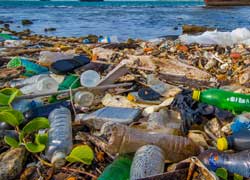New study identifies array of plastic debris in Great Lake tributaries

There has been growing concern in recent years surrounding plastics, and especially microplastics, in aquatic environments. Defined as plastic particles less than 5 mm in diameter, microplastics enter aquatic environments in a number of ways. One source is photodegradation and/or mechanical breakdown of larger items, such as Styrofoam, plastic bags, bottles, wrappers, cigarette butts, and tyres, according to a study, Plastic Debris in 29 Great Lakes Tributaries: Relations to Watershed Attributes and Hydrology, which was recently published in the Environmental Science Technology journal by the American Chemical Society.
Other sources include spillage of preproduction pellets and powders, beadblasting media, and atmospheric deposition are other potential sources. Wastewater treatment plant (WWTP) effluent has also been cited as a source: abrasive microbeads in toilet cleaners, face and hand scrubs, and toothpastes—often made from positively buoyant polyethylene—may pass through WWTPs and into receiving waters.] Other more dense particles, such as polyester fibres, are largely captured in WWTP sludge, which may subsequently be applied over land and remobilised to receiving waters via runoff.
Marine organisms, including mammals, birds, fish, turtles, and invertebrates, have been shown to ingest microplastics. Physical hazards of ingestion can include obstruction of the digestive system, clogging of feeding appendages, oxidative stress, impaired reproduction, and death. In addition, ingestion of microplastics can result in uptake and bioaccumulation of harmful chemicals. Additives in plastics such as phthalates, brominated flame retardants, nonylphenol, and antimicrobials have been associated with cancer and endocrine disruption. The high sorption capacity of plastics enables the accumulation of persistent organic pollutants such as polychlorinated biphenyls, polycyclic aromatic hydrocarbons, and organochlorine pesticides, with concentrations 105–106 times higher than in the surrounding water column. Trace metals and pathogens have also been shown to accumulate on microplastics.
The study characterised the quantity and morphology of floating micro- and macroplastics in 29 Great Lakes tributaries in six states under different land covers, wastewater effluent contributions, population densities, and hydrologic conditions.
Tributaries were sampled three or four times each using a 333 μm mesh neuston net. Plastic particles were sorted by size, counted, and categorised as fibres/lines, pellets/beads, foams, films, and fragments.
According to study authors, Austin K. Baldwin, Sherri A. Mason, and Steven R. Corsi, plastics were found in all 107 samples, with a maximum concentration of 32 particles/m3 and a median of 1.9 particles/m3. About 98% of sampled plastic particles were less than 4.75 mm in diameter and therefore considered microplastics.
Fragments, films, foams, and pellets/beads were positively correlated with urban-related watershed attributes and were found at greater concentrations during runoff-event conditions. Fibres, the most frequently detected particle type, were not associated with urban-related watershed attributes, wastewater effluent contribution, or hydrologic condition. Results from this study add to the body of information currently available on microplastics in different environmental compartments, including unique contributions to quantify their occurrence and variability in rivers with a wide variety of different land-use characteristics while highlighting differences between surface samples from rivers compared with lakes.
(PRA)Copyright (c) 2016 www.plasticsandrubberasia.com. All rights reserved.












































